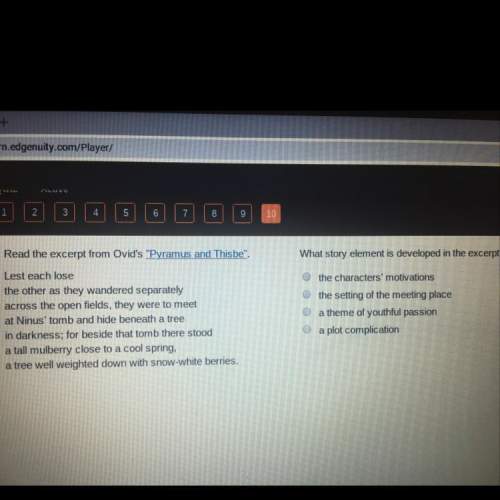
English, 13.12.2019 02:31 darkstorm2277
Which of the following lines from “the prologue” to the canterbury tales is not an example of direct characterization?
a.
“he was an honest worker, good and true . .”
b.
“. . his mighty mouth was like a furnace door.”
c.
“children were afraid when he appeared.”
d.
“he wore a fustian tunic stained and dark . .”

Answers: 2
Another question on English

English, 22.06.2019 03:00
Which most closely describes the author's use of historical information for the novel white fang? consider both texts provided. the author included details and descriptions of the dogs that match the historical details provided. b) the author changed the historical facts about early sled dogs to fit the needs of his plot and setting. c) the author changed the description and age of the dogs, which was necessary for his main character to develop bonds with the dogs. d) the author included historically accurate details of the dogs' working conditions, but the dogs he describes in his story are alaskan huskies.
Answers: 3

English, 22.06.2019 03:00
This excerpt is from the poet by alfred lord tennyson the poem describes a poets consciousness and perception which three lines suggests the richness of a poets thoughts
Answers: 2

English, 22.06.2019 04:00
Which poems include the theme that memories of beautiful natural places benefit the people who recall them? "to spring" and "lines written in early spring" "to autumn" and "to a butterfly" "to summer" and "the human seasons" "i wandered lonely as a cloud" and "lines on a beautiful spring in a village"
Answers: 2

English, 22.06.2019 07:00
Which sentence in this excerpt from leo tolstoy’s the death of ivan ilyich shows the human tendency to contemplate one’s past life? "but if that is so," he said to himself, "and i am leaving this life with the consciousness that i have lost all that was given me and it is impossible to rectify it—what then? " he lay on his back and began to pass his life in review in quite a new way. in the morning when he saw first his footman, then his wife, then his daughter, and then the doctor, their every word and movement confirmed to him the awful truth that had been revealed to him during the night. in them he saw himself—all that for which he had lived—and saw clearly that it was not real at all, but a terrible and huge deception which had hidden both life and death. this consciousness intensified his physical suffering tenfold. he groaned and tossed about, and pulled at his clothing which choked and stifled him. and he hated them on that account. he was given a large dose of opium and became unconscious, but at noon his sufferings began again. he drove everybody away and tossed from side to side. his wife came to him and said: "jean, my dear, do this for me. it can't do any harm and often . healthy people often do it." he opened his eyes wide. "what? take communion? why? it's unnecessary! " she began to cry. "yes, do, my dear. i'll send for our priest. he is such a nice man." "all right. very well," he muttered. when the priest came and heard his confession, ivan ilyich was softened and seemed to feel a relief from his doubts and consequently from his sufferings, and for a moment there came a ray of hope. he again began to think of the vermiform appendix and the possibility of correcting it. he received the sacrament with tears in his eyes.
Answers: 2
You know the right answer?
Which of the following lines from “the prologue” to the canterbury tales is not an example of direct...
Questions

Mathematics, 21.08.2019 07:30

Mathematics, 21.08.2019 07:30


History, 21.08.2019 07:30

English, 21.08.2019 07:30

Biology, 21.08.2019 07:30

Chemistry, 21.08.2019 07:30

Physics, 21.08.2019 07:30





Social Studies, 21.08.2019 07:30

Social Studies, 21.08.2019 07:30

Mathematics, 21.08.2019 07:30


Mathematics, 21.08.2019 07:30







